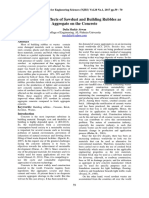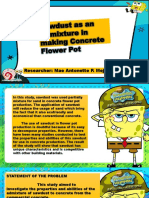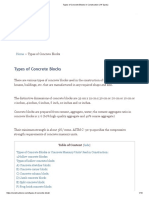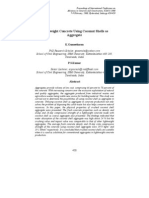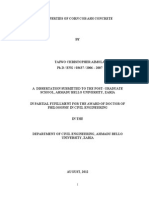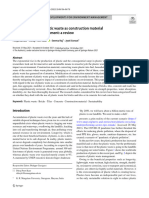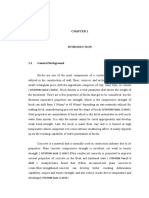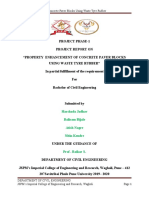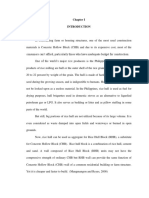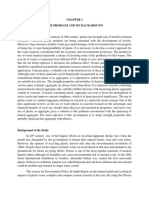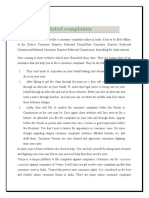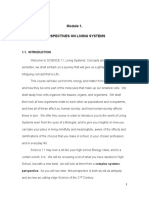Rice Husk Ash-Lime Blended Building Bricks
Rice Husk Ash-Lime Blended Building Bricks
Uploaded by
Melissa FelicianoCopyright:
Available Formats
Rice Husk Ash-Lime Blended Building Bricks
Rice Husk Ash-Lime Blended Building Bricks
Uploaded by
Melissa FelicianoOriginal Title
Copyright
Available Formats
Share this document
Did you find this document useful?
Is this content inappropriate?
Copyright:
Available Formats
Rice Husk Ash-Lime Blended Building Bricks
Rice Husk Ash-Lime Blended Building Bricks
Uploaded by
Melissa FelicianoCopyright:
Available Formats
302
International Journal of Earth Sciences and Engineering ISSN 0974-5904, Vol. 03, No. 02, April 2010, pp. 302-309
Rice Husk Ash - Lime Blended Building Bricks
DR S. M. ALI JAWAID Civil Engineering Department, M M M Engineering College, Gorakhpur-273010, India Email: smaj@rediffmail.com
Abstract: There is a great demand for environmentally safe reuse of rice husk ash thanks to high rate of its generation in India. This is also need of time to develop alternate methods of brick manufacturing in order to reduce the use of fertile soil in brick manufacturing, thus, protecting it for agricultural use. Utilization of rice husk ash with lime in brick manufacturing is reported in this paper. It is found that building bricks prepared by adding 6% of rice husk ash and 2% of lime with alluvial silts, exhibits compressive strength of 106 kg/cm2 and water absorption of 15%. Keywords: Ash Utilization, Rice Husk Ash, Bricks, Building Industry, Flyash, Waste Disposal Introduction: Rice milling generates a by product know as husk. This surrounds the paddy grain. During milling of paddy about 78 % of weight is received as rice, broken rice and bran and rest 22 % of the weight of paddy is received as husk. This husk is used as fuel in the rice mills to generate steam for the parboiling process. This husk contains about 75 % organic volatile matter and the balance 25 % of the weight of this husk is converted into ash during the firing process, is known as rice husk ash ( RHA ). This RHA in turn contains around 85 % - 90 % amorphous silica (Jaturapitakkul and Roongreung, 2003, Gambhir 1995). So for every ton of paddy milled, about 220 kgs (22 %) of husk is produced, and when this husk is burnt in the boilers, about 40 kgs (20 %) of RHA is generated (Mehta 1986). India is a major rice producing country, and the husk generated during milling is mostly used as a fuel in the boilers for processing paddy, producing energy through direct combustion and / or by gasification. About 20 million tones of RHA are produced annually(Srivastava, 2005). It is classified as pozzolanic material according to ASTM C168 (1997 d). Hydrated (or slaked) lime is very effective in treating clays and silts. Lime reacts chemically with available silica and alumina in soils. Natural cement composed of calcium alumino-silicate complexes is formed, which causes a cementing action. The strength of lime stabilized soil is generally improved due to formation of cementing material. Alluvial soil deposit in Indo-gangetic plains of India, predominantly, consists of silts of low to medium compressibility (ML/MI). These deposits are rich in alumina and silica. The water holding capacity of this soil is around 45%. The objective of this research is to utilize the pozolanic effect of rice husk ash in presence of lime and water for making highly cementious and durable bricks using locally available alluvial soils. This will not only reduce the use of fertile soil of this region for brick manufacturing but also, reduce the waste disposal volume to make a better world. Materials and Methods: Materials used in this experimental program consist of rice husk ash (RHA), hydrated lime (HL) and Low/Medium compressibility Silt (ML/MI). RHA was collected from furnaces located at different industrial units in Gorakhpur industrial area. The ash obtained is sieved through 75 microns Indian Standard Sieve in order to remove the unburnt portion of ash. The major chemical and physical properties of RHA are given in Table 1. The commercially available unslaked lime is used in this study. It was pulverized, sieved through 425 micron Indian standard sieve and stored in polyethylene bag in desiccators. Local alluvial soils were collected for this experimental study. The important engineering and chemical properties of soil is given in Table 2. It is reported that 2% of lime when added with rice husk ash and
#02030316 Copyright 2010 CAFET-INNOVA TECHNICAL SOCIETY. All rights reserved.
DR S. M. ALI JAWAID
303
alluvial soil gave maximum strength (Srivastava, 2005). Thus, 2% of lime was added with soil and rice husk ash in this study. Bricks were prepared by mixing the RHA, lime and local alluvial soil in various proportions and conventional brick making technique was adopted (Figures 1 and 2). Improvement in the engineering properties of the brick, so produced, was studied. The percentage of RHA and lime were increased at regular interval and its effect on the compressive strength of the brick was also studied. The same process continued till the RHA-lime-soil mix proportion exhibit a decline in strength. Results and Discussion: The effect of mix proportion on strength, water adsorption capacity and density etc. were studied experimentally and results are tabulated in Table 3. Discussion on results is given in subsequent section. Compressive Strength of Brick: Compressive strength of bricks at different percentage of rice husk ash is shown in Fig. 3. It is evident from Table 3 that the compressive strength of brick so formed increases with increase in rice husk ash content but decreases with the increase in rice husk ash content beyond 6%. Lime reacts with fine pozzolanic component to form calcium-silicate gel with soil particles. The silicate gel proceeds immediately to coat and bind soil particles. In time this gel gradually crystallized into well defined calcium silicate hydrates such as tobermorite and hillebrandite. The reaction ceases on drying and very dry soils will not react with lime or cement (Srivastava, 2005, Ingles, 1972). The mechanism of reaction can be represented as NaS4H + CH NH +CAS4HNS + degradation product NH+C2SH Where S=SiO2, H=H2O, A=Al2O3, C=CaO, N=Na2O and C2SH are the cementitious mixture and contribute to the compressive strength of brick. At an optimum ash percentage, a homogeneous gel formation will take place in the entire soil mass in which all the soil particles will be involved in pozzolanic reaction, which hardens to form cementitious products rendering maximum
compressive strength. Any further increase in ash content will result in excess of rice husk ash which remain unused and prevents the soil particles from point to point contact. The soil grains will float in the matrix of unused ash, resulting in reduction of compressive strength. Density of Brick: It is observed that the density of brick decreases as the percentage of additive (Rice husk ash) increases (Fig. 4). Since the density of the additive (ash) is equal to 0.53 t/m3, it will float in water. The mixing was done with soil by proportion of weight; a great volume of additive will replace the soil volume because of their lower density. This leads to reduction in the density of the brick. Water Absorption of Brick: The major factor affecting the durability of brick is water absorption. The less infiltration of water in the brick, the more durable is the brick. So, the internal structure of brick must be intensive enough to prevent the intrusion of water. The water absorption was determined by using the procedures described in ASTM C67-00 (2000). Fig 5 shows the result of water absorption test for various percentage of rice husk ash-lime soil mixture. It is found that water adsorption property of prepared brick decreases initially with an increase in ash content (Fig 5) up to optimum ash content of 6%. However, it increases afterwards. This is due to fact that addition of additive (ash) to the soil generates the desired heat of hydration which starts the pozzolanic reaction resulting in gel formation. At an optimum ash percentage, a homogeneous gel formation takes place in which all the soil particles will be involve in pozzolanic reaction leading to formation of less porous hard cementitious product. Any further increase in ash proportion in soil will result in excess of ash which remains unused and prevents the soil particles from point to point contact leading to increase in porosity.
International Journal of Earth Sciences and Engineering ISSN 0974-5904, Vol. 03, No. 02, April 2010, pp. 302-309
304
Rice Husk Ash - Lime Blended Building Bricks
Scanning Electron Observations:
Micrographs
Scanning electron microscopy (SEM) technique has been used to visualize the nature of structure of the brick before and after the addition of optimum ash content. The SEM of brick formed with out additive (ash) and with additive at magnification 1546X is shown in Fig. 6 and Fig. 7 respectively. From the micrograph, it can be seen that in conventional brick there are lot of aggregated packets of soil particles (Fig. 6). The soil particles are assembled in such a manner to give higher density and less porosity. Fig. 7 shows the SEM of brick formed after mixing with additive (ash) at optimum percentage. The homogeneous gel formation due to pozzolanic reaction is distinctly seen in the entire soil mass. The silica gel cemented the soil particles to form aggregates crumbs which make the entire soil mass becoming porous. Economic Analysis: Economic analysis was carried out to compare the cost of the construction of brick using conventional soil as well as soil mixed with optimum percentage of ash. The detailed calculation is given elsewhere (Raghatate, 2003). The above analysis reveals the following: 1. There is saving of IRs. 0.80 (US $ 0.016) per brick, if the brick is formed with adding optimum percentage of rice husk ash. 2. By using rice husk ash-lime mixed brick, there is saving of 0.119 m3 of virgin and fertile soil per one thousand bricks. Conclusions: Based on the results obtained in this study, the following conclusions are drawn: 1. Rice husk ash may be successfully used for making bricks. It is found that 6% of ash with 2% lime is optimum percentage to be mixed with Inorganic silt (ML). 2. Compressive strength of the bricks formed by adding optimum ash and lime is 106.0 kg/cm2. Thus, the bricks so formed may be classified as 100 class (I class) brick as per Indian Standards (IS: 1077-1976). 3. Rice husk ash-lime mixed bricks are lighter in weight as compared to
conventional brick. It is due to fact that the density of ash is less than the soil. 4. It is found that water adsorption property of prepared brick decreases initially with an increase in ash content up to optimum ash content of 6% and 2% lime content. However, it increases afterwards. 5. Rice husk ash mixed bricks are showing higher water absorption than the conventional bricks. 6. There is saving of Indian Rupees 0.80 (US$ 0.016) per brick, if the brick is formed with adding optimum percentage of rice husk ash. Also, there is saving of 0.119 m3 of virgin and fertile soil per one thousand bricks. Reference: [1] ASTM (1997). Standard Specification for Coal Fly Ash and Raw or Calcined Natural Pozzolan for use as a Mineral Admixture in Portland Cement Concrete, C618-94a, Annual book of ASTM standards, Vol. 04.02, pp. 294-296. [2] ASTM (2000). Standard Test Method for Sampling and Testing Brick and Structural Clay Tile. C67-00, Annual book of ASTM standards, Vol. 04.05, pp. 41-51. [3] Gambhir, M. L. (1995). Concrete Technology. 2nd Ed. McGraw Hill, New Delhi , pp. 286-287. [4] Indian Standard (1976). Specification of Burnt Clay Bricks (IS: 1077). Bureau of Indian Standards, New Delhi. [5] Jaturapitakkul, C and Roongreung, B. (2003). Cementing Material from Calcium Carbide Residue-Rice Husk Ash. Journal of Materials in Civil Engg, ASCE, Vol. 15, No. 5, pp. 470-475. [6] Mehta, P. K. (1986) Concrete Structures, Properties and Materials. Prentice Hall, Englewood cliffs, N. J. , pp. 266, 273. [7] Raghatate, S. (2003). TechnoEconomic Feasibility Study of Agro-Waste (Ash) Utilization in Brick Industry. M. Tech. Dissertation, U.P. Technical University, India, pp. 80. [8] Srivastava, A. (2005). Environmental Management of Rice Husk Ash Produced in GIDA Project Area, Gorakhpur. M. Tech. Dissertation, U.P. Technical University, India, pp. 100.
International Journal of Earth Sciences and Engineering ISSN 0974-5904, Vol. 03, No. 02, April 2010, pp. 302-309
DR S. M. ALI JAWAID
305
Table 1: Engineering and Chemical Properties of Rice Husk Ash Engineering Properties S. No. 1 2 3 4 5 6 7 Property Specific gravity, G Percent retained on 75 sieve Percent passing 75 sieve Atterbergs limits pH value Water Holding Capacity, % Bulk Density, t/m3 Typical value 2.23 17.5 82.5 Nonplastic 7.93 93.9 0.53 S. No. 1 2 3 4 5 6 7 Chemical Composition Typical Constituent Value, % SiO2 88.00 K2O 4.50 CaO 0.55 MgO SO32Al2O3 Fe2O3 0.35 0.24 0.15 0.16
Table 2: Engineering and Chemical Properties of Soil Engineering Properties S. No. 1 2 3 4 5 6 7 8 Property Specific gravity, G Sand Content, % Silt Content, % Atterbergs limits pH value Water Holding Capacity, % Bulk Density, t/m3 I. S. Classification Typical value 2.70 15.00 85.00 Nonplastic 7.70 44.62 1.80 ML S. No. 1 2 3 4 5 Chemical Composition Typical Value, Constituent % Total Soluble Solids 0.84 CaCO3 12.14 Si 18.72 Al Fe2O3 37.42 2.11
Table 3: Engineering Properties of Tested Brick Samples S. No. 1 2 3 4 5 % of rice husk ash mixed 2.0 4.0 6.0 8.0 10.0 % of lime mixed 2.0 2.0 2.0 2.0 2.0 Compressive strength, kg/cm2 96.50 102.50 106.00 96.15 86.18 Density of brick t/m3 1.76 1.62 1.50 1.45 1.39 Water Absorption, % 15.65 14.50 14.21 15.10 19.52
International Journal of Earth Sciences and Engineering ISSN 0974-5904, Vol. 03, No. 02, April 2010, pp. 302-309
306
Rice Husk Ash - Lime Blended Building Bricks
Figure 1: Moulding of Rice Husk Ash Mixed Brick
Figure 2: Finished Rice Husk Ash-Lime-Soil Mixed Brick
International Journal of Earth Sciences and Engineering ISSN 0974-5904, Vol. 03, No. 02, April 2010, pp. 302-309
DR S. M. ALI JAWAID
307
110 Compressive Strength, kg/cm
2
105 100 95 90 85 80 0 2 4 6 8 10 12 Rice Husk Ash, %
Figure 3: Effect of Rice Husk Ash Percentage on Compressive Strength of Brick.
1.8 1.7 D ensity, t/m3 1.6 1.5 1.4 1.3 0 2 4 6 Rice Husk Ash, %
Figure 4: Effect RHA Percentage on Density of Brick International Journal of Earth Sciences and Engineering ISSN 0974-5904, Vol. 03, No. 02, April 2010, pp. 302-309
10
12
308
Rice Husk Ash - Lime Blended Building Bricks
20 Water absorption criteria for 1st class brick: Below 15% Water Absorption, % 18
16
14
12 0 2 4 6 Rice Husk Ash, %
Figure 5: Effect of RHA Percentage on Water Absorption Properties of Bricks
10
12
Figure 6: SEM of Conventional Brick Formed Without Addition of Ash.
International Journal of Earth Sciences and Engineering ISSN 0974-5904, Vol. 03, No. 02, April 2010, pp. 302-309
DR S. M. ALI JAWAID
309
Figure 7: SEM of Brick Formed after Mixing Soil with Optimum Ash Content.
International Journal of Earth Sciences and Engineering ISSN 0974-5904, Vol. 03, No. 02, April 2010, pp. 302-309
You might also like
- Thesis FinalDocument64 pagesThesis FinalJohn Carlo Amodia0% (1)
- Bricks From Waste Material PDFDocument13 pagesBricks From Waste Material PDFJel SalcedoNo ratings yet
- Stabilization of Clay Soil Using Seashells and Coconut HusksDocument5 pagesStabilization of Clay Soil Using Seashells and Coconut Husksdela rosaNo ratings yet
- Potentials of Rice-Husk Ash As A Soil StabilizerDocument9 pagesPotentials of Rice-Husk Ash As A Soil StabilizerInternational Journal of Latest Research in Engineering and TechnologyNo ratings yet
- Combined Effects of Sawdust and Building Rubbles As Aggregate On The ConcreteDocument12 pagesCombined Effects of Sawdust and Building Rubbles As Aggregate On The ConcreteOudhai VONGKEONo ratings yet
- Plastic TilesDocument2 pagesPlastic TilesAnkit Saxena100% (1)
- Papercrete Brick As An Alternate Building MaterialDocument9 pagesPapercrete Brick As An Alternate Building MaterialHhuNo ratings yet
- SawdustDocument10 pagesSawdustMae MejaresNo ratings yet
- Chapter 1-3 (A)Document26 pagesChapter 1-3 (A)Ram Vincent EvioNo ratings yet
- Compressive Strength of Rice Straw As An Additive in Concrete and Its WorkabilityDocument5 pagesCompressive Strength of Rice Straw As An Additive in Concrete and Its WorkabilityRichelle DandoNo ratings yet
- The Effectiveness of Dried Water Hyacinth (Eichhornia Crassipes) Woven Into Mat To Prevent Soil ErosionDocument3 pagesThe Effectiveness of Dried Water Hyacinth (Eichhornia Crassipes) Woven Into Mat To Prevent Soil ErosionJm CampitanNo ratings yet
- Compressive Strength of Concrete Using Sawdust As AggregateDocument5 pagesCompressive Strength of Concrete Using Sawdust As AggregateMohammedNo ratings yet
- "Making of Economical Tiles Using Plastic Waste": Project Presentation OnDocument38 pages"Making of Economical Tiles Using Plastic Waste": Project Presentation OnShantanu JadhavNo ratings yet
- Chapter 2 Literature ReviewDocument26 pagesChapter 2 Literature ReviewSalvatory Lyakurwa67% (3)
- Concrete Using Coconut ShellsDocument4 pagesConcrete Using Coconut ShellsUmange RanasingheNo ratings yet
- Definition of Soil The Composition of The SoilDocument39 pagesDefinition of Soil The Composition of The SoilZainab QuddoosNo ratings yet
- Cement NotesDocument59 pagesCement NotesDharshan KNo ratings yet
- PapercreteDocument6 pagesPapercreterenato garciaNo ratings yet
- Rice Husk Ash As A Partial Replacement of Cement in The Production of Hollow BlocksDocument15 pagesRice Husk Ash As A Partial Replacement of Cement in The Production of Hollow BlocksShelina ObnimagaNo ratings yet
- Partial Replacement of Cement With Corn Cob AshDocument11 pagesPartial Replacement of Cement With Corn Cob AshTIZA MICHAEL B.Engr., BBS, MBA, Aff. M. ASCE, ASS.M. UACSE, M. IAENG. M.ITE.No ratings yet
- Corn Cob PDFDocument5 pagesCorn Cob PDFMadan Mohan ReddyNo ratings yet
- Analysis of Eggshell Powder As Partial Replacing Material in ConcreteDocument6 pagesAnalysis of Eggshell Powder As Partial Replacing Material in ConcreteJohn Mark VidaNo ratings yet
- Chapter IDocument10 pagesChapter IDanielaNo ratings yet
- Coconut Husk FiberDocument12 pagesCoconut Husk FiberArnie Romero CrispinoNo ratings yet
- Plastic Mixed Reinforced ConcreteDocument10 pagesPlastic Mixed Reinforced ConcreteUmange RanasingheNo ratings yet
- Types of Concrete Blocks in Construction (14 Types)Document10 pagesTypes of Concrete Blocks in Construction (14 Types)hhNo ratings yet
- Factor Affecting Quality of TimberDocument3 pagesFactor Affecting Quality of TimberJitesh Aneja100% (1)
- Experimental Study On Human Hair As Fiber Reinforced ConcreteDocument5 pagesExperimental Study On Human Hair As Fiber Reinforced ConcreteYogendra PatilNo ratings yet
- Soil Progress ReportDocument13 pagesSoil Progress ReportJohn Rhey Almojallas Benedicto100% (1)
- COconut Shell PaperDocument10 pagesCOconut Shell PaperPeer MohamedNo ratings yet
- 3-Clay BrickDocument22 pages3-Clay BrickZhiwar oramariNo ratings yet
- Historical Context: Interlocking Compressed Earth Block (ICEB)Document3 pagesHistorical Context: Interlocking Compressed Earth Block (ICEB)Stewart Paul TorreNo ratings yet
- Properties of Corn Cob Ash ConcreteDocument238 pagesProperties of Corn Cob Ash ConcreteENgřMuhăɱɱadRiǺzAhɱad88% (8)
- Recycling Reuse of Plastic Waste As Construction Material For Sustainable Development A Review (31.08.2023)Document24 pagesRecycling Reuse of Plastic Waste As Construction Material For Sustainable Development A Review (31.08.2023)Velchuri SairamNo ratings yet
- Experiments On Partial Replacement of Coconut Shell As Coarse Aggregate in ConcreteDocument10 pagesExperiments On Partial Replacement of Coconut Shell As Coarse Aggregate in ConcreteIJIRSTNo ratings yet
- Sample Capstone PDFDocument17 pagesSample Capstone PDFMark Julius FulgencioNo ratings yet
- Chapter 1-4Document57 pagesChapter 1-4Hadi Iz'aanNo ratings yet
- Effect of Pulverized Ricce Husk On Clay Roof TilesDocument27 pagesEffect of Pulverized Ricce Husk On Clay Roof TilesVinasoy JeffreyNo ratings yet
- Utilization of Banana Peel Powder in ConcreteDocument2 pagesUtilization of Banana Peel Powder in ConcreteEditor IJTSRDNo ratings yet
- Review of Related Literature and Studies 2.1 Related Readings and LiteratureDocument4 pagesReview of Related Literature and Studies 2.1 Related Readings and LiteratureArjelyNo ratings yet
- Production of Hollow Block Using Waste Plastic and SandDocument17 pagesProduction of Hollow Block Using Waste Plastic and SandMauricio David Ruiz Odar100% (1)
- Utilization of Corncob Particles As Structural BoardDocument17 pagesUtilization of Corncob Particles As Structural BoardMohammad Nasif Basman Saga100% (1)
- Use of Coconut Shell As An Aggregate in Concrete: A ReviewDocument2 pagesUse of Coconut Shell As An Aggregate in Concrete: A ReviewInnovative Research PublicationsNo ratings yet
- Thesis Cap 1Document6 pagesThesis Cap 1Leigh Mina SurmilaNo ratings yet
- Property Enhancement of Concrete Paver BlocksDocument37 pagesProperty Enhancement of Concrete Paver BlocksHarshada JadhavNo ratings yet
- Waste Wood Ash and Saw Dust Chapter 1-3Document14 pagesWaste Wood Ash and Saw Dust Chapter 1-3JayChristian QuimsonNo ratings yet
- A Study On The Optimization of Burning Residual As A Concrete Additive Used As A CHB Wall AlternativeDocument47 pagesA Study On The Optimization of Burning Residual As A Concrete Additive Used As A CHB Wall AlternativeSam Russel Sison100% (1)
- Banana Fiber Board Building Blocks MadeDocument2 pagesBanana Fiber Board Building Blocks MadeJohn Philip GarciaNo ratings yet
- Project Proposal - Banana Fibre BoardDocument8 pagesProject Proposal - Banana Fibre BoardAlleahna Marie danielNo ratings yet
- Coconut Shell As A Replacement of Coarse AggregateDocument8 pagesCoconut Shell As A Replacement of Coarse AggregateM Sohaib AshfaqNo ratings yet
- Thesis ContentDocument39 pagesThesis ContentSunshine Dangkeo50% (2)
- The Feasibility Study of Using Oyster Shells As Substitute in Manufacturing BricksDocument27 pagesThe Feasibility Study of Using Oyster Shells As Substitute in Manufacturing BricksDarla MamuyacNo ratings yet
- Group 3Document10 pagesGroup 3Jarred Allen Z. ServañaNo ratings yet
- Characterization of Carbonized Corn Cob Particles As Potenial Biosorbents On Removing of Copper From Contaminated WaterDocument15 pagesCharacterization of Carbonized Corn Cob Particles As Potenial Biosorbents On Removing of Copper From Contaminated WaterKrishiaDeVeraNo ratings yet
- SoilDocument9 pagesSoilRajeevSangamNo ratings yet
- The Probability of Using Pulverized Mussel Shells As Component in Hollow Block MakingDocument20 pagesThe Probability of Using Pulverized Mussel Shells As Component in Hollow Block MakingNala TigerNo ratings yet
- Utilization of Pulverized Oyster Shell and Pineapple Fiber For Fiber Cement Board Production 1Document4 pagesUtilization of Pulverized Oyster Shell and Pineapple Fiber For Fiber Cement Board Production 1TRISTAN REY BACLAAN100% (2)
- Performance Evaluation of Water Hyacinth Fiber Reinforced Self-CompactingDocument40 pagesPerformance Evaluation of Water Hyacinth Fiber Reinforced Self-CompactingcarlooooNo ratings yet
- Waste Plastic As AggregateDocument9 pagesWaste Plastic As AggregateFrank PingolNo ratings yet
- MultiScienceJ E2023004 - Ani and Nahid (2023) Development of Brick by Utilizing Rice Husk Ash As The Partial Replacement For ClayDocument8 pagesMultiScienceJ E2023004 - Ani and Nahid (2023) Development of Brick by Utilizing Rice Husk Ash As The Partial Replacement For Clayfranklloyd27No ratings yet
- Deep Web Answers From 4chanDocument2 pagesDeep Web Answers From 4chanDante Marco Antonio Solis Sparda64% (11)
- Video Game Pitch Deck by SlidesgoDocument26 pagesVideo Game Pitch Deck by SlidesgoJunaid IqbalNo ratings yet
- Brantford Games Network Lab - Blog - The Eight Roles For Escape Room SuccessDocument1 pageBrantford Games Network Lab - Blog - The Eight Roles For Escape Room SuccesspeterNo ratings yet
- MYP - IDU PHE - Science - Sports ScienceDocument9 pagesMYP - IDU PHE - Science - Sports ScienceDaniela Rocha100% (1)
- Key Components of OBE and AccreditationDocument61 pagesKey Components of OBE and Accreditationpvs-1983No ratings yet
- Tecnical Drawing Grade 11Document2 pagesTecnical Drawing Grade 11fikaduNo ratings yet
- English: Quarter 4 - Module 1Document16 pagesEnglish: Quarter 4 - Module 1rappidoNo ratings yet
- Historical Reconstruction of Socio-Economic System in Khorezm Oasis On The Archeology of The Neolithic PeriodDocument5 pagesHistorical Reconstruction of Socio-Economic System in Khorezm Oasis On The Archeology of The Neolithic PeriodresearchparksNo ratings yet
- Pulsar Spectroscopy BR PDFDocument20 pagesPulsar Spectroscopy BR PDFafasdg100% (2)
- Hazard Identification and Risk Assessment (HIRA) in Textile IndustryDocument7 pagesHazard Identification and Risk Assessment (HIRA) in Textile IndustryAjesh mohan0% (1)
- LocksDocument2 pagesLockssaandeepdNo ratings yet
- Gesturist AnalysisDocument2 pagesGesturist Analysisᴋnᴏʙɪ ゞNo ratings yet
- Aerogel Safety Data SheetDocument6 pagesAerogel Safety Data SheetMiroslav Ambruš-KišNo ratings yet
- Categories and ObjectsDocument5 pagesCategories and ObjectsazarNo ratings yet
- Chat Room For Teens 1Document141 pagesChat Room For Teens 1thaocung2003No ratings yet
- Capital Intensity, Leverage, Return On Asset,: Dan Ukuran Perusahaan Terhadap Agresivitas PajakDocument14 pagesCapital Intensity, Leverage, Return On Asset,: Dan Ukuran Perusahaan Terhadap Agresivitas PajakNana AlhusnaNo ratings yet
- Foundation of EducationDocument111 pagesFoundation of EducationChikahantayo TVNo ratings yet
- Temperature WorksheetDocument2 pagesTemperature WorksheetbondanmiabaamNo ratings yet
- Consumer Related ComplaintsDocument4 pagesConsumer Related ComplaintsArpit NaruNo ratings yet
- ES - Module 5 II B. Exogenic ProcessesDocument18 pagesES - Module 5 II B. Exogenic ProcessesKristine Joyce BesmonteNo ratings yet
- SD_Module 2 Session 2Document46 pagesSD_Module 2 Session 2SAMMY BOY GUZMANNo ratings yet
- An-611 Application Note: 50 Hz/60 HZ Rejection On - AdcsDocument4 pagesAn-611 Application Note: 50 Hz/60 HZ Rejection On - AdcsGeorge AcostaNo ratings yet
- Module 1-Perspectives On Living SystemsDocument26 pagesModule 1-Perspectives On Living SystemsSebastian Smythe100% (1)
- Topic: Coastal Management Objective: Hard/ Soft Engineering MethodsDocument3 pagesTopic: Coastal Management Objective: Hard/ Soft Engineering Methods2025 MENSAH JohnNo ratings yet
- John Dewey'S Educational Philosophy Applied in The PhilippinesDocument35 pagesJohn Dewey'S Educational Philosophy Applied in The PhilippinesVengie PamanNo ratings yet
- Automatic Traffic Light ControllerDocument35 pagesAutomatic Traffic Light ControllerAmamhossain50% (2)
- Geostock 2015 Activity Report PDFDocument28 pagesGeostock 2015 Activity Report PDFIslemNo ratings yet
- Empirical RuleDocument25 pagesEmpirical RuleJash Antoneth TimbangNo ratings yet
- 2-A. - ELC II - UNIT 6 MODALS ABILITY OBLIGATION - ADVICE - PERMISSIONDocument6 pages2-A. - ELC II - UNIT 6 MODALS ABILITY OBLIGATION - ADVICE - PERMISSIONYuliana PaezNo ratings yet
- PHT 5917 2020re A/L Physics - Amith PussellaDocument37 pagesPHT 5917 2020re A/L Physics - Amith PussellaSanjaya JayandraNo ratings yet




